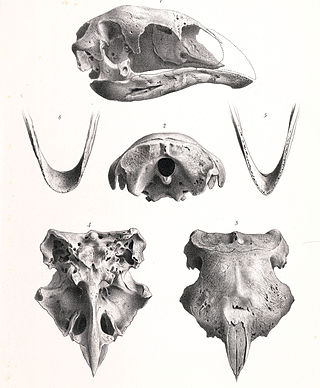Top Qs
Timeline
Chat
Perspective
Broad-billed moa
Extinct bird species From Wikipedia, the free encyclopedia
Remove ads
The broad-billed moa, stout-legged moa,[5][6] or coastal moa (Euryapteryx curtus) is an extinct species of moa that was endemic to New Zealand.
Remove ads
Taxonomy
Euryapteryx curtus is a ratite and a member of the lesser moa family. The ratites are flightless birds with a sternum without a keel. They also have a distinctive palate.[7]
A 2009 genetic study showed that the species Euryapteryx gravis is a junior synonym of E. curtus.[8] Following this, a study published in 2010 explained size differences among the remains as being a result of sexual dimorphism.[9] A 2012 morphological study interpreted them as subspecies instead.[10] E. c. curtus, the nominate subspecies, was labeled the "coastal moa",[1] while E. c. gravis was the "stout-legged moa".[2]
The cladogram below follows a 2009 analysis by Bunce et al.:[11]
| Dinornithiformes |
| ||||||||||||||||||||||||||||||
Remove ads
Habitat and distribution

Euryapteryx curtus was one of the most widespread moa species, inhabiting mostly open areas.[6] These moa lived on both the North and the South Islands of New Zealand, and remains have also been recovered from nearby Stewart Island. It inhabited lowland environments like duneland, forest, shrubland, and grassland.[7]
Behaviour and ecology
As of 2006, half of all complete or mostly complete moa eggs in museum collections are likely broad-billed moa specimens.[12] Of the specimens traditionally given the name Euryapteryx gravis, the eggs have an average length of 205 mm (8.1 in) and width of 143 mm (5.6 in), while the group traditionally assigned to the name Euryapteryx curtus had an average length of 122 mm (4.8 in) and width of 94 mm (3.7 in).[12]
The species presumably went extinct for the same reasons as proposed for other moa: overhunting by the Māori (who called them "moa hakahaka") after their arrival on the islands in the 14th century.[2]
References
External links
Wikiwand - on
Seamless Wikipedia browsing. On steroids.
Remove ads


